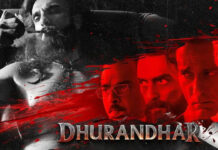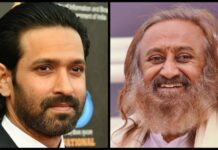Balaji Telefilms Ltd. and White Feather Films’ Shootout At Wadala (A) is a gangster film. Manohar alias Manya Surve (John Abraham) is a bright and principled college-going student who loves Vidya (Kangana Ranaut). His step-brother, Bhargav (Vinit Sharma), a gangster, is attacked by goons and although Manya is not keen on saving him, Vidya forces him to go to his rescue. Even while Manya is saving Bhargav, he (Bhargav) kills one of the attackers. This leads to the arrest of Manya and Bhargav and they both are imprisoned for life. In jail, Bhargav is killed. Manya becomes friends with Sheikh Mohd. Yunus Munir (Tusshar Kapoor) in the prison and trains under another undertrial who is a body-builder (Sanjeev Chadha).
One day, Manya and Munir escape from jail. Manya kills a few people including the one (Ranjeet) responsible for the state in which he is, and police officer Ambolkar (Raju Kher) who had very mercilessly arrested the brothers and humiliated Manya. Police officer Aafaque Baagraan (Anil Kapoor) is after Manya and he is assisted by police officers Rajan Ambat (Ronit Roy) and Bhende (Mahesh Manjrekar).
The drama also shows the achievements of Aafaque who arrests Yakub Lala (Raju Mawani) and Sayed Batla (Pankaj Kalra) for killing a man and raping his wife while they were honeymooning. Yakub and Batla are part of the Mastan gang. The gang has Sadiq (Arif Zakaria), editor of a newspaper, murdered because he exposes Yakub and Batla. Working for Sadiq are Zubair Imtiaz Haksar (Manoj Bajpayee) and his younger brother, Dilawar Imtiaz Haksar (Sonu Sood), two underworld dons.
As the drama progresses, Manya rubs Zubair and Dilawar the wrong way and one fine day, murders Zubair. Dilawar is now thirsting for Manya’s blood and kills Manya’s accomplice, Gyancho (Siddhanth Kapoor), when he refuses to reveal Manya’s whereabouts. He also grievously injures Munir for the same reason.
What happens in the end? Does Manya kill Dilawar or does Dilawar avenge his elder brother’s murder by eliminating Manya? Or does Dilawar join forces with the police to wipe out Manya? Is it that Manya and the police join hands to kill Dilawar? Does the police succeed in wiping out Manya? Or does inspector Aafaque sympathise with Manya?
The film is partly based on S. Hussain Zaidi’s book, Dongri To Dubai: Six Decades Of The Mumbai Mafia. Sanjay Gupta and S. Hussain Zaidi’s story is quite interesting but there is an inherent problem in the screenplay written by Sanjay Gupta, Abhijeet Deshpande and Sanjay Bhatia. The drama is unable to conclusively establish who the hero is – is it Manya or Zubair or Dilawar or Aafaque? The rise of Manya in the underworld is not very well-established as a result of which he doesn’t appear as too much of a threat to Zubair and Dilawar. Probably the biggest drawback of the screenplay is that it oscillates between the events in Manya’s life and those in Aafaque’s life before Manya even met Aafaque. This confuses the audience as the drama of Aafaque’s encounters before he meets Manya seem irrelevant. There is nothing wrong in showing the achievements of the principled police officer but the way the screenplay is structured (in flashback), the relevance of the police inspector’s feats is not very clear. Also, there are just too many characters in the film, adding to the confusion.
While the heavy dose of action, violence, bloodshed and gore will appeal greatly to the single-screen cinema audience, it will not be equally lapped up by the multiplex-frequenting audience. The first half is interesting and engaging as new characters keep getting introduced. Except for a few dips in the screenplay before interval (soon after the ‘Laila teri le legi’ song and before and during the ‘Manya’ song), the first half is fast-paced and interesting. Post-interval, there is so much violence and bloodshed that it will put off classes, families and womenfolk. The screenplay after interval seems to have gone haywire because it is not clear whether the real fight is between Manya and Zubair or between Manya and Aafaque. Due to this, the viewer does not experience a high in the climax. In other words, the screenplay confuses the audience which is, therefore, not able to make up its mind whether to sympathise with and hold hands of Manya or Aafaque. In fact, in a way, both, Manya and Aafaque are genuinely nice people – Manya is a man ruined by circumstances, while Aafaque wants to rid society of underworld dons. Therefore, when Aafaque goes after Manya, the viewer gets confused as one ‘hero’ is pitted against the other ‘hero’. Also, since Manya is shown to be killing mainly the wrong-doers, his goodness rather than his evil side gets underlined. The scene in which Dilawar beats Munir to pulp is juxtaposed with Manya running like a maniac to seemingly beat the daylights out of Dilawar, but what Manya does is just save Munir from the clutches of Dilawar and run away from the scene with him (Munir). This scene makes Manya’s character look ridiculously stupid and timid. Also, Manya screaming time and again in frustration (in the second half) looks weird because dons are meant to frustrate people with their power and authority, not to themselves feel frustrated.
Besides sex, the film has action as its main selling point because it lacks in three important ingredients of a commercial film, viz. romance, comedy and emotions.
Milap Milan Zaveri’s dialogues are a major asset of the film. They are weighty and thoroughly mass-appealing. However, the excessive use of crude and vulgar four-letter words, which may go well with the mood of the film, will definitely put off the ladies and family audiences, thereby restricting the film’s appeal.
John Abraham acts very well. He looks the character and exposes his physique and action prowess to the hilt. But the scenes showing him shouting and screaming in frustration, as mentioned above, look uncalled for. The film also lacks in John’s heroism. Kangana Ranaut may not have a key role but she, nevertheless, performs ably. Anil Kapoor acts with admirable ease and gives his cent per cent to the role. Tusshar Kapoor easily and brilliantly slips into the character of Munir and plays his part with a rare ease. Manoj Bajpayee is wonderfully natural and leaves a very good impression. Sonu Sood is pretty effective. Ronit Roy is splendid with his understated acting. Mahesh Manjrekar does not get enough scope; he is good. Vinit Sharma leaves a mark. Siddhanth Kapoor makes a promising debut as Gyancho. Arif Zakaria is nice in a brief role. Sanjeev Chadha makes his presence felt with his bare body. Raju Kher has his moments. Raju Mawani and Pankaj Kalra play the two rapists effectively. Soni Razdan is natural. As Potya, Chetan Hansraj is okay. Sunny Leone sizzles in the ‘Laila teri le legi’ song-dance, exposing her anatomy enough for the masses to salivate. Priyanka Chopra’s dance in the ‘Babli badmaash’ is also sexy. Sophie Chaudry lends oomph in the ‘Aala re’ song. Jackie Shroff is okay in a special appearance. Akbar Khan (as Maqsood) and Karan Patel (as Jameel) are fairly nice. Sangeeta Khonayat (as the raped woman), Randheer Rai (as the murdered husband), Gargi Patel (as Vidya’s mother), Jaswinder Gardner (as Rajan Ambat’s wife) and the rest of the actors lend ordinary support.
Sanjay Gupta’s direction is very good. He has made a fast-paced and sleek film but even his direction is unable to camouflage the shortcomings of the script. Music, composed by Anu Malik, Anand Raaj Anand, Meet Bros. Anjjan and Mustafa Zahid, is good but not universally hit. The ‘Laila teri le legi’ song (Anand Raaj Anand) is very mass-appealing and so is the ‘Babli badmaash’ number (Anu Malik) but their appeal for the classes is limited. ‘Aala re’ (Anu Malik) is quite nice. The ‘Manya’ song deserves to be deleted from the film. Lyrics (Neelesh Misra, Kumaar, Sanjay Gupta and Anand Raaj Anand) cater to the masses and the wordings of a couple of songs may put off the class and family audience. Picturisations of the three dance numbers (by Ahmed Khan) are sexy and mass-appealing. It must be mentioned here that the ‘Babli badmaash’ song comes abruptly. Amar Mohile’s background music is dramatic enough. Tinnu Verma and Alan Amin’s action and stunt scenes are too violent and will be liked by the masses mainly. Sameer Arya and Sanjay F. Gupta’s cinematography is splendid. Sets (Sunil Nigwekar) are authentic. Bunty Nagi’s editing is good.
On the whole, Shootout At Wadala is a very violent film meant for the masses and the single-screen cinemas more than for the classes, families and multiplex-frequenting public. A large section of the womenfolk will keep away from the film due to the excessive violence and foul language. Its business in Bombay and Maharashtra will be good because of the flavour of the film. Since it has been sold to distributors for the various territories and its satellite rights have also fetched a huge amount of money, it will prove to be a profitable proposal for the producers but several of its distributors will not be able to recover their heavy investments. Its business in Bombay and Maharashtra will be good because of the flavour of the film.
Released on 3-5-’13 at Inox (daily 8 shows), Liberty (daily 3 shows), Metro Big (daily 11 shows) and other cinemas of Bombay by Balaji Motion Pictures. Publicity: very good. Opening: fair to good. …….Also released all over. Opening was very good in single-screen cinemas of Maharashtra, fairly nice in single-screen cinemas outside Maharashtra, and quite dull at many multiplexes. Collections picked up at 25% of the places as the day progressed.




























